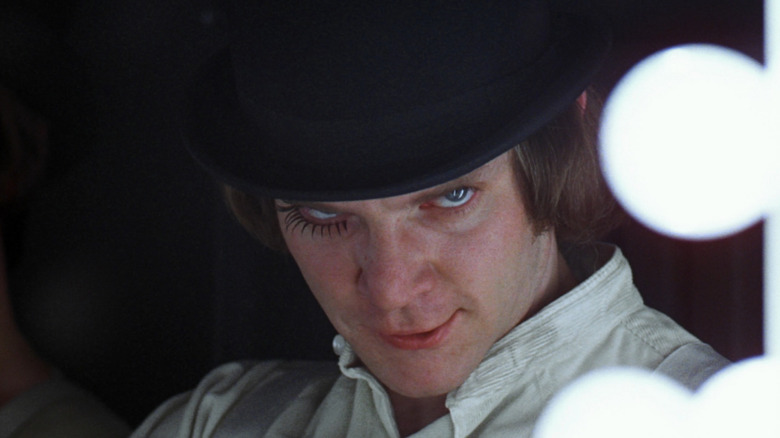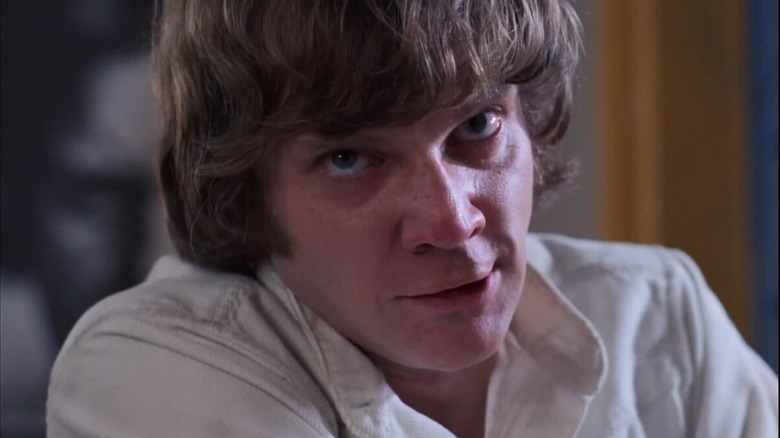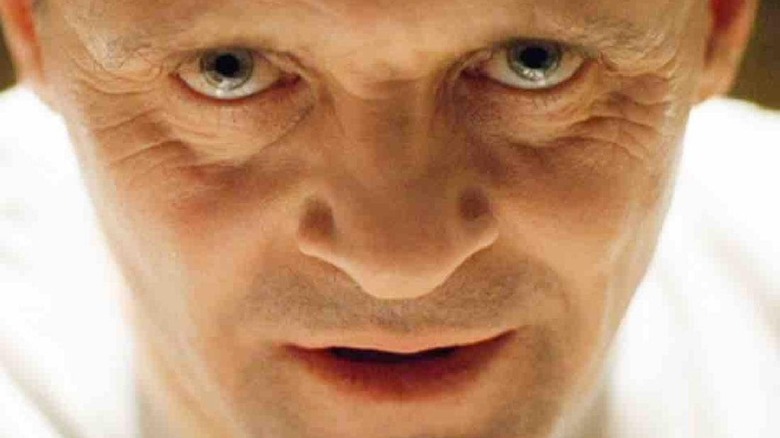How Malcolm McDowell Created The Signature 'Kubrick Stare'
One of the most identifiable — and imitated — cinematic tropes is the "Kubrick Stare," a particular type of close-up shot used in several films by director Stanley Kubrick. It turns up in "The Shining," "Full Metal Jacket," and "Eyes Wide Shut," and to a lesser extent, "Lolita" and "2001: A Space Odyssey."
Those latter two films don't quite fit the "Kubrick Stare" mold because they were made prior to the "Stare's" concrete origin point: 1971's "A Clockwork Orange." Although Kubrick had used close-ups in a unique and piercing fashion since his debut feature, "Fear and Desire," it was "Clockwork" that perfected and defined the usage of the "Stare": namely, to denote a character's inner menace, mystery, and/or madness.
It was the perfect look for the character of Alex DeLarge, the film's antihero who is such a purveyor of "the old ultra-violence" that he becomes the guinea pig for a government-approved brainwashing technique. Kubrick ultimately decided Alex's stare would be the very first shot of the movie, a long and methodical pullback from a close-up of Alex's face that would not just introduce the character but the tone and world of the film. Yet despite Kubrick clearly having experience with shot composition, it was actor Malcolm McDowell who created the "Stare," causing it to be defined not just for his character and the film but for future Kubrick movies.
Beethoven + drugs = Kubrick Stare
McDowell was well aware that the opening shot of "A Clockwork Orange" would be crucial to hooking an audience and holding their interest. The character of Alex was a challenging one right from the script, and although McDowell had gotten some advice from his "If..." director Lindsay Anderson on how to play the character (Anderson suggested this close-up from "If" as a starting point), Kubrick's suggested preparation for the actor was varied and troubling. Kubrick also knew that the look of Alex in the opening shot would signal what kind of film "Clockwork" was to be, so the character had to already be found before the scene could be filmed.
Fortunately, McDowell and Kubrick were able to discover the signature look for Alex while shooting a later scene in which the young Droog listens to his beloved "Ludwig Van" in his bedroom. As McDowell recalled, "It came up because [Kubrick] said, 'I need some kind of look for when you hear the music.'" The director told McDowell that he was "going to play the Beethoven Choral Symphony real loud" and that the actor should just "see what happens." As the music played, "this look came" onto McDowell's face, and Kubrick began laughing "because the eyes were kind of up and glazed over and the mouth kind of took on a weird look."
That look, which became the "Kubrick Stare," was a combination of various aspects of Alex's character and the film that were known to McDowell: he was "supposed to be a little high," and although Alex was a deranged and unrepentant criminal and rapist, he and Kubrick "were making a comedy, let's face it." So, Kubrick's uproarious response to McDowell was when they knew they'd found the look, and McDowell knew that "all I had to do was repeat it for that beginning shot."
The stare that launched a thousand close-ups
The opening shot of "A Clockwork Orange" turned out to be so compelling that it not only defined that film but much of Kubrick's work going forward. Each of his subsequent features contained a close-up where a character would give some version of the "Stare," and even his past movies seemed to contain some nascent version of it.
Thanks to the continued popularity of Kubrick's films, the "Stare" still turns up in a wide variety of media, from comic books to TV shows as well as movies. For example, versions of it can be seen in "Stranger Things," "Game of Thrones," "The Silence of the Lambs," "Mulholland Dr.," and even the poster for Tommy Wiseau's "The Room." Granted, neither Kubrick nor McDowell have ownership over the close-up, nor an actor's choice to appear ambiguously menacing. There's no doubt, however, that without McDowell, Kubrick, and "A Clockwork Orange," such a stare would look altogether different.


